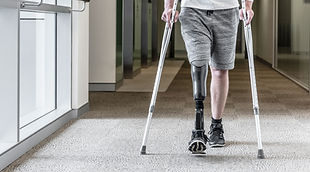

OsteoArthritis
Home Physio specializes in diagnosing and carefully treating Osteoarthritis while making sure each patient is fully informed throughout the process. Serving the Central, West & North London , Home Physio is known for delivering outstanding results while helping you minimize your personal investment and creating a suitable treatment plan for your needs.
Home / Conditions / Osteoarthritis

What causes osteoarthritis
Osteoarthritis is also sometimes called degenerative joint disease.
The surfaces on the joints can become damaged so the joint doesn’t work as smoothly. For example, cartilage, which acts like padding on joints, can be lost over time.
Osteoarthritis is more common as people get older and is often thought of as the result of wear and tear on the body. People are more likely to develop it from their late 40s. It is more common among women than men.
Risk factors also include being overweight, previous disease or injury to a joint and an individual’s genes.
Symptoms and signs
Pain and stiffness around joints can be symptoms of osteoarthritis. These tend to be worse at the end of the day or after resting and might ease off as you move around.
Swelling - either hard or soft - is another sign that can suggest osteoarthritis.
People with osteoarthritis might feel their joints grating or grinding and find that they cannot use them properly because the joint doesn’t move as freely or as far as before.
Joints such as knees, wrists and shoulders are commonly affected. So too are the neck, base of the thumb, base of the big toe, hips and the lower back.
Diagnosis
Your GP or a specialist doctor may diagnose osteoarthritis based on your symptoms and the signs they can see, such as swelling and stiffness. An x-ray is often used to confirm a diagnosis as this may show reduced space between joints. Though sometimes x-ray findings are not reflective of the symptoms a person may experience.
Blood tests cannot show whether a person has osteoarthritis but might be used to rule out other conditions. MRI scans aren’t generally used to diagnose osteoarthritis as they focus more on soft tissue such as muscles and tendons but they might be used to look for another joint or bone problem.

Treatment
Treatment for osteoarthritis could include medication for pain relief (sometimes called analgesics), pain management, exercise and lifestyle change, physiotherapy, and when necessary surgery and joint replacement.
Medication
Currently, doctors recommend taking regular paracetamol and / or medication called topical non-steroidal anti-inflammatory drugs (also called NSAIDs pronounced ‘en-saids’). This could be ibuprofen gel, arthritis cream or patches, for example.
If these don’t work, doctors may prescribe opioids such as codeine or topical capsicum.
Although glucosamine is thought to help build cartilage, there is currently no evidence that over-the-counter glucosamine is effective in treating osteoarthritis.
Medicine and non-pharmacological treatments can work well together sometimes. Non-pharmacological here means pain relief that isn’t medicine, such as exercise or massage.
Managing pain
Understanding pain can help patients manage it better. Pain is our brain’s response to something it believes to be a threat. The feeling of pain prompts us to try to protect ourselves. Our feeling of pain is influenced by anxiety, stress, fear and mood.
Our previous experience of pain or injury, belief about the cause of symptoms and social support can all affect how we feel pain. Quality and quantity of sleep and weight can also affect pain.

Exercise
People with arthritis worry about exercising because they think their pain and / or their arthritis might get worse. But exercising is actually really important in managing osteoarthritis. Research shows people with arthritis can and should exercise.
Exercise is considered to be the most effective non-drug treatment for reducing pain and increasing mobility in osteoarthritis.
Remember, getting moving often helps relieve the stiffness and pain caused by osteoarthritis so appropriate exercise is really important.
Benefits of exercise
Eases stiffness, improves movement in joints and strengthens muscles.
Improves general fitness, can be enjoyable and sociable and help your mental wellbeing.
All these can help you feel more well.
Effects of not exercising
Avoiding exercising can affect our overall fitness and make general aches and pains more likely.
Losing fitness can result in losing strength in our muscles.
Moving around less can result in more stiffness and discomfort, lead to poor posture and then result in more aches and pain.
Understanding that a certain level of discomfort from exercise can be normal and that moving around often alleviates it can be helpful. Discomfort from osteoarthritis is also normal and does not mean that exercise should be avoided. Also, pain does not necessarily mean that more damage is being caused.
What type of exercise is best for osteoarthritis?
There is no one type of exercise ideal for osteoarthritis. More important is for patients to find something that suits them and that they enjoy. However, it is a good idea to aim for a mixture of:
-
stretching (range of movement, flexibility)
-
strengthening (resistance)
-
aerobic (cardiovascular or fitness exercise).
Tips for exercising:
-
Look for exercises or activities that you enjoy.
-
Start gently and build up gradually.
-
Try to do a mix of stretching, strengthening and aerobic activities.
-
Be patient: it can take time to find something that suits you and listen to your body when deciding how hard to work and when to rest.
How much exercise is right?
If you have painful joints, little and often is a good way to start: aim for 5 to 10 minutes each day, remembering to start gently and gradually increase the time. Aim to reach:
-
30 minutes of exercise 3 times a week, plus
-
30 minutes on your feet per day walking or climbing stairs. This could be broken down into smaller chunks.
Thinking about how you personally gauge pain, aim for no more than 3 or 4 out of 10 on your pain scale to avoid pain flaring up in the 24 hours after you have exercised.
Avoid exhausting yourself or ending up in extreme discomfort. Any discomfort should wear off within an hour or so. If you are in pain the next day, rest and take a break from exercising for a day. Try again the day after but take it more gently.
_edited.png)





